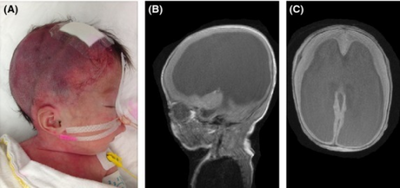Walker–Warburg syndrome
| Walker–Warburg syndrome | |
|---|---|
| Other names: HARD syndrome,Warburg syndrome | |
 | |
| Walker–Warburg syndrome has an autosomal recessive pattern of inheritance. | |
Walker–Warburg syndrome (WWS), also called Warburg syndrome, Chemke syndrome, HARD syndrome (Hydrocephalus, Agyria and Retinal Dysplasia), Pagon syndrome, cerebroocular dysgenesis (COD) or cerebroocular dysplasia-muscular dystrophy syndrome (COD-MD),[1] is a rare form of autosomal recessive congenital muscular dystrophy.[2] It is associated with brain (lissencephaly, hydrocephalus, cerebellar malformations) and eye abnormalities.[3] This condition has a worldwide distribution. The overall incidence is unknown but a survey in North-eastern Italy has reported an incidence rate of 1.2 per 100,000 live births. It is the most severe form of congenital muscular dystrophy with most children dying before the age of three years.[3]
Symptoms and signs

The clinical manifestations present at birth are generalized hypotonia, muscle weakness, developmental delay with mental retardation and occasional seizures.[4]
The congenital muscular dystrophy is characterized by hypoglycosylation of α-dystroglycan.
Those born with the disease also experience severe ocular and brain defects. Half of all children with WWS are born with encephalocele, which is a gap in the skull that will not seal. The meninges of the brain protrude through this gap due to the neural tube failing to close during development. A malformation of the a baby's cerebellum is often a sign of this disease. Common ocular issues associated with WWS are abnormally small eyes and retinal abnormalities cause by an underdeveloped light-sensitive area in the back of the eye.[5]
Genetics
Several genes have been implicated in the etiology of Walker–Warburg syndrome,[6] and others are as yet unknown. Several mutations were found in the protein O-Mannosyltransferase POMT1 and POMT2 genes, and one mutation was found in each of the fukutin and fukutin-related protein genes. Another gene that has been linked to this condition is Beta-1,3-N-acetylgalactosaminyltransferase 2 (B3GALNT2).[7]
Diagnosis
Laboratory investigations usually show elevated creatine kinase, myopathic/dystrophic muscle pathology and altered α-dystroglycan. Antenatal diagnosis is possible in families with known mutations. Prenatal ultrasound may be helpful for diagnosis in families where the molecular defect is unknown.[8]
Prognosis
No specific treatment is available. Management is only supportive and preventive. Those who are diagnosed with the disease often die within the first few months of life. Almost all children with the disease die by the age of three.[8]
Eponym
WWS is named for Arthur Earl Walker and Mette Warburg (1926-2015), a Danish ophthalmologist.[9][10][11] Its alternative names include Chemke’s syndrome and Pagon’s syndrome, named after Juan M. Chemke and Roberta A. Pagon.[12]
References
- ↑ Online Mendelian Inheritance in Man (OMIM): 236670
- ↑ Vajsar J, Schachter H (2006). "Walker–Warburg syndrome". Orphanet J Rare Dis. 1: 29. doi:10.1186/1750-1172-1-29. PMC 1553431. PMID 16887026.
- ↑ 3.0 3.1 "Walker-Warburg syndrome | Genetic and Rare Diseases Information Center (GARD) – an NCATS Program". rarediseases.info.nih.gov. Archived from the original on 2018-04-09. Retrieved 2018-04-09.
- ↑ Reference, Genetics Home. "Walker-Warburg syndrome". Genetics Home Reference. Archived from the original on 2018-07-28. Retrieved 2018-04-17.
- ↑ Weiss, Thomas C.. "Walker-Warburg Syndrome - Facts and Information." Disabled World. N.p., 6 Mar. 2010. Web. 8 Dec. 2013. <http://www.disabled-world.com/disability/types/mobility/md/walker-warburg.php Archived 2021-08-29 at the Wayback Machine>.
- ↑ Beltrán-Valero de Bernabé D, Currier S, Steinbrecher A, et al. (November 2002). "Mutations in the O-mannosyltransferase gene POMT1 give rise to the severe neuronal migration disorder Walker–Warburg syndrome". Am. J. Hum. Genet. 71 (5): 1033–43. doi:10.1086/342975. PMC 419999. PMID 12369018.
- ↑ Maroofian R, Riemersma M, Jae LT, Zhianabed N, Willemsen MH, Wissink-Lindhout WM, Willemsen MA, de Brouwer APM, Mehrjardi MYV, Ashrafi MR, Kusters B, Kleefstra T, Jamshidi Y, Nasseri M, Pfundt R, Brummelkamp TR, Abbaszadegan MR, Lefeber DJ, van Bokhoven H (2017) B3GALNT2 mutations associated with non-syndromic autosomal recessive intellectual disability reveal a lack of genotype-phenotype associations in the muscular dystrophy-dystroglycanopathies. Genome Med 9(1):118. doi: 10.1186/s13073-017-0505-2
- ↑ 8.0 8.1 Vajsar J, Schachter H (2006). "Walker-Warburg syndrome". Orphanet J Rare Dis. 1: 29. doi:10.1186/1750-1172-1-29. PMC 1553431. PMID 16887026.
- ↑ synd/1202 at Who Named It?
- ↑ Walker AE (1942). "Lissencephaly". Archives of Neurology and Psychiatry. 48: 13–29. doi:10.1001/archneurpsyc.1942.02290070023002.
- ↑ Warburg M (March 1971). "The heterogeneity of microphthalmia in the mentally retarded". Birth Defects Orig. Artic. Ser. 7 (3): 136–54. PMID 4950916.
- ↑ "Walker-Warburg syndrome". Archived from the original on 2017-09-20. Retrieved 2021-08-11.
Further reading
- HARD syndrome; Walker–Warburg syndrome; Chemke syndrome; COD (cerebroocular dysgenesis) at NIH's Office of Rare Diseases
External links
| Classification | |
|---|---|
| External resources |